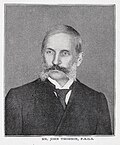English: Ruined Temples of Cambodia. Western collonade of the Temple of Ongau Wat, Cambodia. Illustration for The Illustrated London News, 1 February 1868.
Date: Saturday, Feb. 1, 1868, Publication: The Illustrated London News (London, England), Volume: 52, page 118, Issue: 1467, page 5.
Read the ILN
THE RUINED TEMPLES OF CAMBODIA. Few architectural monuments of a remote antiquity in Asia are more curious than the ruined temples of Cambodia, adjoining Siam. The once extensive and powerful kingdom of Cambodia, Khmer, or Khamain, is situated between Siam and Cochin-China, and from its southern extremity, in the Gulf of Siam, extends between 14 deg. and 15deg. N. lat., and from 103 deg. to 107 deg. E. long. This country was explored and described, eight or nine years ago, by the late M. Henri Mouhot, the naturalist ; and it has been visited more recently by Mr. J. Thomson, a photographic artist, residing at Bangkok, the capital of Siam. Mr. Thomson, having come home, a year or two since, laid the results of his observations, with a series of photographs, before the Royal Geographical Society, and also before the Geographical and Ethnological section of the British Association for the Advancement of Science. He gave a particular account of his visit to Ongou Wat; the "Wat," or Buddhist temple, at Ongou or Ongcor, otherwise called Nakou or Nokhor, the ancient capital of Cambodia, now in rains. It lies near the head of the great lake, Touli Sap, through which the Mekon river flows from Cambodia into the Gulf of Siam. The site is almost entirely surrounded by a thickly-grown forest of enormous trees, infested with lions and tigers. The history of Cambodia is almost unknown; the present race of natives state that a flight of angels came down from heaven and built these temples. The vastness of the temples of Ongon suggests comparison with the pyramids of Egypt, and the artistic conception and design of the whole with the classic edifices of Greece. From its extent it appears to have been the work of several generations, and from its symmetry the work of a single genius. " It was with feelings of intense awe," says Mr. Thomson, "that ne left the forest path to ascend the worn steps of the outer causeway. On our left a colossal statue of a lion lay half buried in the sand. Standing on the great outer causeway our eyes wandered from its exquisitely-fitted blocks of freestone across the broad ditch which surrounds the temple to :he great entrance of the western gallery, whose massive square pillars stood out in bold relief in the bright sunshine, but beyond the great central mitre-shaped tower about 700 yards distant. We passed through the entrance of the gallery to find a second causeway of greater extent; there we saw the temple in all its magnificence, with its pillared galleries rising tier above tier, and terminating in the great tower. We ascended through sculptured staircases, colonnades, and corridors, crossed over paved courts having ornamental reservoirs, until we reached the central tower." The rectangular walled inclosure of the temple measures 10'0 yards by 1100 yards, and is surrounded by a moat 230 yards wide, which completes an outer rectangle of nearly an English mile each way. A splendid causeway across the western moat, adorned by pillars on each aide, leads to the great gateway, itself a structure of five stories in height, and having, with its wings included, a facade of 600 ft. Beyond, a second raised causeway, 370 yards long, leads to a cruciform platform, in front of the proper temple. The temple itself consists of three inclosures, one within the other, each raised from 15ft. to 20ft. above the level of that outside it, so as to give the whole a pyramidal form. Tne outer inclosure measures 570 ft. by 650ft. This has three portals on each face, adorned with towers, and externally is surrounded entirely by double open galleries or verandahs, or, rather, peristyles. These have very much the relative proportion of a nave and aisle, the wider (10) ft.) being next the wall. The inner and larger pillars have elegant capitals, but no base. A design is carved on the flat at the lower part, and an incised ornament carried up the edge of the shafts; this is the case also with the outer pillar, which has base and plinth. Of such pillars there are 400 or 500 in the outer inclosure alone, without reckoning the inner inclosures of the temple, where there are hundreds more. Moreover, the walls of the colonnade are sculptured, to the full length of some 2000 ft. from top to bottom ; and the number of men and animals represented is from 18 000 to 20,000. Numerous female statues appear on the pilasters, but no male. The pillars are very correctly proportional, and surmounted by a proper architrave, a frieze, which within the temple receives elaborate sculpture, and a cornice, which displays infinite rows and repetitions of seven-headed serpents. In the ancient city of Ongou Thornm, situated a little north of Ongou Wat, many of the ruins are supposed to be of superior antiquity to that of Ongon Wat, and in their grotesque sculptures bear more resemblance to the antiquities of Hindostan, Ceylon, and Java. These remains of former magnificence show the high state of civilisation the ancient Cambodians had arrived at. Their empire is now an empty name. We have been permitted by Mr. Thomson to engrave two of the views photographed by him, one representing the western facade, another the western colonnade of Ongou Wat. It is, perhaps, needless to remark that the tiger introduced by our draughtsman into one of these scenes does not appear in the photograph; but tigers are said to frequent the neighbourhood of the ruins.




